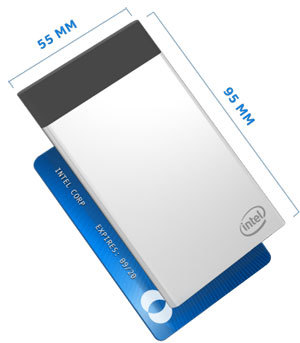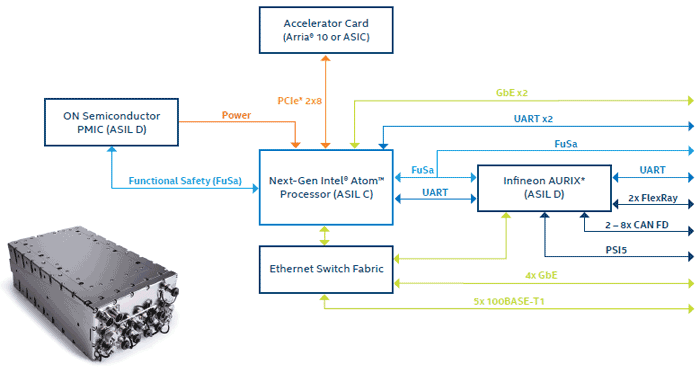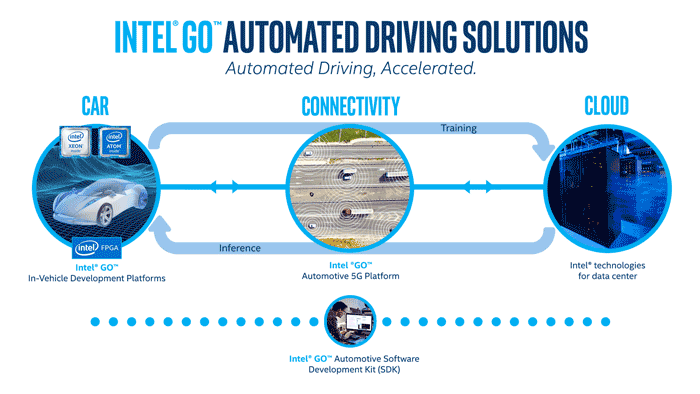Intel at CES 2017: plans for the year
The Consumer Electronics Show , held annually in Las Vegas, with all its show in the title, plays not only an entertaining, but also an important educational and educational role. Conveniently settling down at the very beginning of the year, it gives an idea of the directions that the leading manufacturers of digital and computer equipment plan to pay special attention in the next months. It turns out something like creative work "how I will spend this year." So, given the changes in the general line of many, even the largest vendors (and Intel is not an exception) - even in the absence of super announcements, it makes sense to take a walk on the informational reasons of CES, to look at the trends. We will study our own.

 Two years ago, at the same CES, only in 2015, Intel introduced the Compute Stick - a full- featured x86 computer in the HDMI whistle format. Now we see a more flattened product - the Intel Compute Card . In addition, if the Stick is a compact consumer computer, the Card is a component of "smart things." Intel's idea is this: any manufacturer can realize its product in the hardware of the necessary functionality, even though a refrigerator, even a demonstration display, providing control, monitoring and communications to the Compute Card - all you need to do is to put a slot for this card with a single USB-C + interface, to which USB , PCIe, HDMI and DP.
Two years ago, at the same CES, only in 2015, Intel introduced the Compute Stick - a full- featured x86 computer in the HDMI whistle format. Now we see a more flattened product - the Intel Compute Card . In addition, if the Stick is a compact consumer computer, the Card is a component of "smart things." Intel's idea is this: any manufacturer can realize its product in the hardware of the necessary functionality, even though a refrigerator, even a demonstration display, providing control, monitoring and communications to the Compute Card - all you need to do is to put a slot for this card with a single USB-C + interface, to which USB , PCIe, HDMI and DP.
The platform is fully ready for use, as they say, “just add everything else”, but its technical characteristics, except for the size, are still unknown. It is promised to provide full TTH in the second quarter of 2017, the commercial launch is the middle of the year.
Intel has been working hard for a long time, although, in my subjective opinion, it is somewhat haphazardly working to increase the intelligence of vehicles. We have repeatedly written about systems designed to solve this problem, and here is a new approach - Intel GO .
')

Intel GO Atom processor-based architecture
Intel GO, like the Compute Card, is a complete hardware platform, based on the Intel Atom or Intel Xeon processor in combination with the Altera FPGA (for scalability and optimal cost), the Infineon AURIX controller (for interacting with the car’s peripherals and sensors) , power management chip from ON Semiconductor, network controllers and 5G communication module. The latter is worth noting separately: at CES, Intel introduced the first commercial model of a 5G chip, which in just a few months will be ready to take its place in real communication systems, components of the “Internet of things” and cars as well.

Intel GO Automotive Software Development Kit is responsible for the software implementation of a specific automotive functionality, as well as for its maximum optimization and acceleration. It includes a library and computer vision, in-depth study, processing and layout of information, driving and ensuring its safety - in short, everything that can be useful to the developers of ADAS.
The 7th generation of processors (Kaby Lake) is announced in full swing - the line is now wide, you can announce for a long time. The next generation Cannon Lake and the new 10-nm process technology are on the way, so the rumors about the death of Moore's law were premature.
Let me remind you that Kaby Lake is the first experience of Intel in the transition from a two-stroke (tick-to-three) to a three-stroke processor development scheme. The third stage, I find it difficult to call it hourly, is set aside for optimizing performance and power consumption in the framework of the current process technology. However, judging by the first preliminary tests , it has not yet been possible to achieve the promised “substantial increase”.

7th generation Intel Core processor design and nomenclature
Be that as it may, the planned move has been made. At this stage , desktop models of processors along the entire length, from i3 to i7, among them, according to tradition, are models with both fixed and unlocked multipliers, as well as Pentium and Celeron processors. In the near future, the range will be expanded, younger models will be added, as well as processors for mobile and portable devices.
Virtual reality is still the main focus of the Intel program, both in the pavilion and at the reporting events. The demonstrations were really impressive: here is a virtual tour of the solar power station, and 360-degree panoramas of Vietnamese nature - the spectators just in case were given vomiting bags, in case the sensations turn out to be too unexpected.

In fact, apart from the impressive views, there are not so many events in this area.
These are the results of CES 2017. Well, ahead of the next winter IDF and something new, for sure.

Intel Compute Card
 Two years ago, at the same CES, only in 2015, Intel introduced the Compute Stick - a full- featured x86 computer in the HDMI whistle format. Now we see a more flattened product - the Intel Compute Card . In addition, if the Stick is a compact consumer computer, the Card is a component of "smart things." Intel's idea is this: any manufacturer can realize its product in the hardware of the necessary functionality, even though a refrigerator, even a demonstration display, providing control, monitoring and communications to the Compute Card - all you need to do is to put a slot for this card with a single USB-C + interface, to which USB , PCIe, HDMI and DP.
Two years ago, at the same CES, only in 2015, Intel introduced the Compute Stick - a full- featured x86 computer in the HDMI whistle format. Now we see a more flattened product - the Intel Compute Card . In addition, if the Stick is a compact consumer computer, the Card is a component of "smart things." Intel's idea is this: any manufacturer can realize its product in the hardware of the necessary functionality, even though a refrigerator, even a demonstration display, providing control, monitoring and communications to the Compute Card - all you need to do is to put a slot for this card with a single USB-C + interface, to which USB , PCIe, HDMI and DP.The platform is fully ready for use, as they say, “just add everything else”, but its technical characteristics, except for the size, are still unknown. It is promised to provide full TTH in the second quarter of 2017, the commercial launch is the middle of the year.
Automotive platform Intel GO
Intel has been working hard for a long time, although, in my subjective opinion, it is somewhat haphazardly working to increase the intelligence of vehicles. We have repeatedly written about systems designed to solve this problem, and here is a new approach - Intel GO .
')

Intel GO Atom processor-based architecture
Intel GO, like the Compute Card, is a complete hardware platform, based on the Intel Atom or Intel Xeon processor in combination with the Altera FPGA (for scalability and optimal cost), the Infineon AURIX controller (for interacting with the car’s peripherals and sensors) , power management chip from ON Semiconductor, network controllers and 5G communication module. The latter is worth noting separately: at CES, Intel introduced the first commercial model of a 5G chip, which in just a few months will be ready to take its place in real communication systems, components of the “Internet of things” and cars as well.

Intel GO Automotive Software Development Kit is responsible for the software implementation of a specific automotive functionality, as well as for its maximum optimization and acceleration. It includes a library and computer vision, in-depth study, processing and layout of information, driving and ensuring its safety - in short, everything that can be useful to the developers of ADAS.
7th Generation Intel Core Processors
The 7th generation of processors (Kaby Lake) is announced in full swing - the line is now wide, you can announce for a long time. The next generation Cannon Lake and the new 10-nm process technology are on the way, so the rumors about the death of Moore's law were premature.
Let me remind you that Kaby Lake is the first experience of Intel in the transition from a two-stroke (tick-to-three) to a three-stroke processor development scheme. The third stage, I find it difficult to call it hourly, is set aside for optimizing performance and power consumption in the framework of the current process technology. However, judging by the first preliminary tests , it has not yet been possible to achieve the promised “substantial increase”.

7th generation Intel Core processor design and nomenclature
Be that as it may, the planned move has been made. At this stage , desktop models of processors along the entire length, from i3 to i7, among them, according to tradition, are models with both fixed and unlocked multipliers, as well as Pentium and Celeron processors. In the near future, the range will be expanded, younger models will be added, as well as processors for mobile and portable devices.
Augmented Reality
Virtual reality is still the main focus of the Intel program, both in the pavilion and at the reporting events. The demonstrations were really impressive: here is a virtual tour of the solar power station, and 360-degree panoramas of Vietnamese nature - the spectators just in case were given vomiting bags, in case the sensations turn out to be too unexpected.

In fact, apart from the impressive views, there are not so many events in this area.
- The project of glasses of the combined reality Project Alloy, announced at the last IDF , over the past months, according to the leadership of Intel, “has advanced significantly.” We can be convinced of this by the end of the year, when several OEM manufacturers will bring their models of these glasses to the market.
- In November, Intel acquired VOKE , a company engaged in broadcasting systems for various entertainment events and events through augmented reality glasses. Let me remind you that earlier in 2016, Replay was acquired and its unique technology of three-dimensional video broadcasting.
- Alliances have been created with a number of related players in the joint development and promotion of VR technologies. We will obviously see the results of this cooperation when we get the VR devices on our hands.
These are the results of CES 2017. Well, ahead of the next winter IDF and something new, for sure.
Source: https://habr.com/ru/post/400665/
All Articles